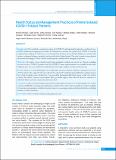Please use this identifier to cite or link to this item:
https://hdl.handle.net/20.500.14356/932| Title: | Health Status and Management Practices of Home Isolated COVID-19 Adult Patients |
| Authors: | Parajuli, kristina Silwal, Sashi Acharya, Astha Poudyal, Anil Dhakal, Neelam Pandey, Ashok Neupane, Tamanna Bista, Bihungum Dhimal, Meghnath Gyanwali, Pradip |
| Citation: | Parajuli kristina, SilwalS., AcharyaA., PoudyalA., DhakalN., PandeyA., NeupaneT., BistaB., DhimalM., & GyanwaliP. (2023). Health Status and Management Practices of Home Isolated COVID-19 Adult Patients. Journal of Nepal Health Research Council, 20(3), 593-598. https://doi.org/10.33314/jnhrc.v20i3.4155 |
| Issue Date: | 2022 |
| Publisher: | Nepal Health Research Council |
| Keywords: | COVID-19 Home isolation Mental Physical social |
| Series/Report no.: | July-Sep, 2022;4155 |
| Abstract: | Abstract Background: The worldwide containment strategy for COVID-19 outbreak includes laboratory-confirmed cases, and their isolation and management in health care institutions or at home. The spread of the COVID-19 virus has mandated home isolation for mild cases, as recommended by the Government of Nepal. Isolation is a situation that can have a substantial influence on physical and mental health of isolated people. This study is aimed to assess physical and mental well-being of COVID-19 home isolated patients, and their home management practices. Methods: A descriptive cross-sectional research using quantitative methods was carried out. Purposive sampling was used to select COVID-19 patients. Total 536 COVID-19 home isolated patients were included in this study. Telephonic interview was conducted to obtain the data. Descriptive analysis was done and interpreted. Results: About 34 % of the participants were symptomatic. The most common symptoms experienced were fever (22.6%), followed by cough (19.4%) and cold (16.1%). About 20 % indicated having difficulties isolating at home due to lack of separate room. Furthermore, 4 percent of the participants didn’t have anyone to take care of them at home. Also almost 2 percent of participants didn’t get family support when infected. Moreover, majorities of individuals had normal stress, depression and anxiety level. Conclusions: Most of the participants' physical and mental health was found to be normal though some of them experienced difficulties for management during home isolation. Hence, Interventions should focus resilience building by improving communication to address fears and concerns, encouraging routines and physical activities, and taking measures to reduce loneliness. Keywords: COVID-19; home isolation; mental; physical; social. |
| Description: | Original Article |
| URI: | http://103.69.126.140:8080/handle/20.500.14356/932 |
| ISSN: | Print ISSN: 1727-5482; Online ISSN: 1999-6217 |
| Appears in Collections: | Vol 20 No 3 Issue 56 july-Sep, 2022 |
Files in This Item:
| File | Description | Size | Format | |
|---|---|---|---|---|
| 4155-Manuscript-30762-1-10-20230314.pdf | Fulltext Article. | 232.43 kB | Adobe PDF |  View/Open |
Items in DSpace are protected by copyright, with all rights reserved, unless otherwise indicated.
